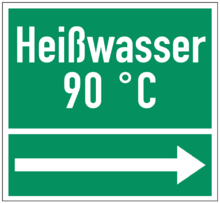DIN 2403
The DIN standard DIN 2403 describes the labeling of underground pipelines according to their flow material. A distinction is made between 10 groups. A distinction between the pipe colors is essential in terms of proper maintenance and effective fire fighting. It also serves to point out dangers and to avoid accidents and damage to health.
General
A label must contain:
General information
- Group color and additional color of the flow substance according to the table below.
- The direction of flow is indicated by an arrow.
- The flow substance must be indicated by specifying the name, a chemical formula or an identification number in the appropriate color.
Additional information
- If it is a hazardous substance according to the Chemicals Act, appropriate hazard symbols must be attached.
- If it is a radioactive substance, corresponding warnings must be attached in accordance with DIN 4844-2.
Furthermore, the information may be supplemented by operating states that describe the pressure, the temperature or the physical state. Further safety marks or other parameters may also be applied.
Color table
The table describes the RAL color assigned to the respective flow group as well as the font color that is to be used for the labeling and the arrows.
| Flow material | group | RAL color | RAL number | Color example | Additional color |
Font color | comment |
|---|---|---|---|---|---|---|---|
| oxygen | 0 | Signal blue | RAL5005 | - | White | ||
| water | 1 | Signal green | RAL6032 | - | White | including water vapor condensate | |
| Steam | 2 | Signal red | RAL3001 | - | White | ||
| air | 3 | Signal gray | RAL7004 | - | black | ||
| Flammable gases | 4th | Signal yellow / signal red | RAL1003 / RAL3001 | black | including liquefied gases | ||
| Non-flammable gases | 5 | Signal yellow / signal black | RAL1003 / RAL9004 | black | including liquefied gases | ||
| Acids | 6th | Signal orange | RAL2010 | - | black | including gases that react acidic with water | |
| Alkalis | 7th | Signal violet | RAL4008 | - | White | including gases which are alkaline with water | |
| Flammable liquids | 8th | Signal brown / signal red | RAL8002 / RAL3001 | White | |||
| Non-flammable liquids | 9 | Signal brown / signal black | RAL8002 / RAL9004 | White |
The groups are divided into sub-classes depending on the substance.
Labelling

Pipelines are to be clearly and permanently marked in their entire circumference and at most every 10 m over the entire length of the pipe as well as at points that are important for operation and that pose a risk (beginning, end, wall penetrations, fittings). Signs as well as self-adhesive foils or tapes are to be used for identification, the pipes themselves are to be painted in the corresponding group color.
The size of the marking and the associated font size depend on the required recognition distance.
literature
- Günter Wossog (Ed.): Handbook of pipeline construction. 2nd edition, Vulkan Verlag, Essen 2003, ISBN 3-8027-2723-1 .
- Peter Kiehl (Ed.): Introduction to the DIN standards. 13th edition, BG Teubner Verlag, Wiesbaden 2001, ISBN 978-3-519-26301-2 .
Web links
- Pipe marking (accessed on January 30, 2020)
- Marking (of pipelines according to the flow substance) DIN 2403 purpose / basis (accessed on January 30, 2020)
- Allocation of the colors to the flow substances according to DIN 2403 (accessed on January 30, 2020)
- Pipe identification according to DIN 2403 (accessed on January 30, 2020)
- Information sheet for pipe marking (accessed on January 30, 2020)